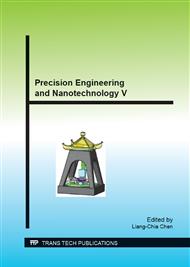p.706
p.712
p.717
p.722
p.728
p.736
p.742
p.748
p.754
Wettability of Polymeric Bionic Surface Replicated from Ginkgo Leaves
Abstract:
Ginkgo is one of the oldest extant seed plants through hundreds of millions of years of evolution. Ginkgo biloba has many unique properties and applications such as drug development and drinking tea. In recent years hydrophobic surfaces with bionic structures have attracted increasing interest for fundamental research and practical applications. As we all know, the Ginkgo leaf has remarkable texturing surface. In this manuscript, wettability of the bionic surface replicated from Ginkgo leaves was explored. The Ginkgo leaves were used as the original mold, from which microstructures were replicated into the surface of polydimethylsiloxane (PDMS). Compared with the topography of Ginkgo leaves, the topographical surface of PDMS was investigated by optical microscopy and scanning electron microscopy. By measuring the contact angle of polymeric bionic surfaces, there is the increase of ~20 degree than flat PDMS surfaces. Mechanical compression was applied on the polymeric bionic surfaces in one dimension, with the real-time measurement of the contact angle. The experimental results reveal that the wetting behavior of the surface can be reversibly tuned by applied mechanical stress, which induces the change in micro-scale topography. This research provides a guide for fabricating and tuning hydrophobic surfaces for various surface engineering applications.
Info:
Periodical:
Pages:
736-741
Citation:
Online since:
August 2014
Authors:
Keywords:
Price:
Сopyright:
© 2015 Trans Tech Publications Ltd. All Rights Reserved
Share:
Citation:



